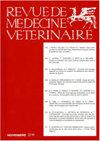Descripción clínica de hemangiosarcoma (HSA) cutáneo metastásico en un canino galgo: estudio clínico de un caso
Q2 Veterinary
引用次数: 3
Abstract
Hemangiosarcoma (HSA) is a type of cancer that has different clinical presentations and therefore different effects, since, depending on each case, different treatment options will exist. While in the case of cutaneous HSA the first line of treatment is always surgical removal of the tumor, metastatic foci should be sought and then perform chemotherapy, despite them having a low metastatic potential. Moreover, the low survival that exists in this type of cancer is a factor that should be communicated to those responsible for the pets, so that, with all available information, they can make a free and informed choice about the treatment they want for their pet, considering the financial commitment, survival time and quality of life associated with chemotherapy. This article describes the clinical case of a female greyhound dog of eight years of age that was brought to consultation for a skin tumor on the right hind limb in the distal tibia. She was diagnosed with noninvasive cutaneous HSA through histopathology, reason why the owners chose not to do the chemotherapy; however, 10 months later she presented recurrent skin lesions and a popliteal lymph node corresponding to hemangiosarcoma and hemangioma respectively, and three weeks later the patient developed cardiac tamponade due to a cardiac mass with associated spill, which resulted in her euthanasia.灰狗转移性皮肤血管肉瘤(HSA)的临床描述:一个病例的临床研究
血管肉瘤(HSA)是一种具有不同临床表现和不同效果的癌症,因为根据每个病例,存在不同的治疗方案。而在皮肤HSA的情况下,治疗的第一线总是手术切除肿瘤,尽管转移灶具有低转移潜力,但仍应寻找转移灶,然后进行化疗。此外,这种癌症存在的低存活率是一个应该与宠物的负责人沟通的因素,这样,在所有可用的信息下,他们可以在考虑与化疗相关的财务承诺、生存时间和生活质量的情况下,自由和知情地选择他们想要为宠物进行的治疗。这篇文章描述了一个临床病例的雌性灰狗八岁,被带到咨询皮肤肿瘤在胫骨远端右后肢。经组织病理学诊断为非侵袭性皮肤HSA,主人选择不做化疗的原因;然而,10个月后,患者出现复发性皮肤病变和腘窝淋巴结,分别对应于血管肉瘤和血管瘤,三周后,患者因心脏肿块合并溢出而出现心脏填塞,最终导致安乐死。
本文章由计算机程序翻译,如有差异,请以英文原文为准。
求助全文
约1分钟内获得全文
求助全文
来源期刊

Revue De Medecine Veterinaire
农林科学-兽医学
CiteScore
1.30
自引率
0.00%
发文量
0
审稿时长
18-36 weeks
期刊介绍:
The Revue de Médecine Vétérinaire publishes four kinds of text:
1) Scientific reviews on subjects related to veterinary and comparative medicine. Suggested length: 10 to 30 typed pages.
2) Original reports on fundamental or applied research. Suggested length: 10 to 15 typed pages.
3) Continuous education articles, that should be easily understandable by non-specialists. Suggested length: 10 to 15 typed pages.
4) Clinical reports. Suggested length: 5 to 15 typed pages.
The publication can be done in French language or English language.
For an article written in English by not english native speakers authors, the manuscript must be subjected by attesting that it was read again by an anglophone scientist or a scientific translator.
The authors must certify that the manuscript was not published or subjected for publication to another review.
The manuscript must be accompanied by a sheet signed by all the joint authors indicating their agreement for the tender of the manuscript.
The publication is free but a financial participation could be required for the photographs color. An estimate will be sent to collect the agreement of the authors.
 求助内容:
求助内容: 应助结果提醒方式:
应助结果提醒方式:


